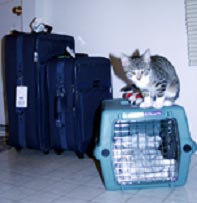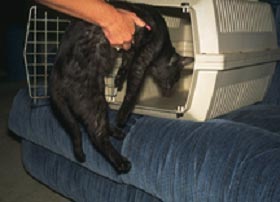Why
are cats so reluctant to travel?
Cats
are highly attached to territory,
and movement away from that
secure base is not something
that is undertaken lightly!
Traveling in cars, planes and
other forms of human transport
can be a very stressful experience
for all concerned, in part,
because the cat is no longer
in control of its own experience.
For some cats, being confined
in a travel container adds insult
to injury and the cat's
fear of leaving its familiar
surroundings is compounded by
its fear of being enclosed.
My
cat seems to get worse with
every journey – why doesn't
he get used to it?
For
most cats travel is a relatively
uncommon experience and there
is simply not enough opportunity
for any significant level of
habituation to be achieved.
Unlike dogs, who come to see
the car as a chance to accompany
their owners on what might be
a fun and adventurous outing,
most cats see travel as an entirely
negative experience and the
likely  destinations
of feline transport confirm
this. Visiting destinations
such as veterinary clinics,
boarding kennels, and unfamiliar
or new homes are probably the
most common destinations for
a travelling cat and none of
these give much scope for teaching
cats that transport is fun! destinations
of feline transport confirm
this. Visiting destinations
such as veterinary clinics,
boarding kennels, and unfamiliar
or new homes are probably the
most common destinations for
a travelling cat and none of
these give much scope for teaching
cats that transport is fun!
I
want my cat to travel happily
in the car – can I teach
it?
Cats
can certainly learn to enjoy
car travel and there are cats
that actively seek the inside
of the family car and sit purring
on the parcel shelf for the
entire journey. In most cases
these cats have been taught
to travel and the best time
to teach them is when they are
very young. There is a period
in the kitten's life when
it is most open to new ideas
and when it can come to accept
just about anything as being
normal, provided that it is
fun! Unfortunately this period
is very early in kittens and
therefore the responsibility
for introducing kittens to car
travel would need to be undertaken
by breeders, but few breeders
have the time to ensure that
all of their charges are taken
for daily trips in the car.
Realistically it will be the
new owners who need to start
the introduction process and,
even when the primary period
of sensitivity to habituation
has passed, short frequent car
trips that are pure pleasure
will still be very valuable.
Taking along a few treats or
play toys and insuring that
the first few trips are to pleasant
destinations can help to insure
only positive experiences. Although
cats perching in the back window
of a car may look cute it is
important to ensure that your
cat is under control during
a journey and in most cases
this will mean confining the
cat to a carrier of some sort
while it is in the car.
My
cat reacts badly to the carrier–
what can I do?
One
of the major sources of stress
for cats during travel is confinement
within a cat carrier and the
fact that the carriers are only
used when the cat needs to go
somewhere is highly significant.
For many cats the destination
is not particularly pleasant
and very rapidly the cat will
develop a strong negative association
with the carrier, seeing it
as a signal of the impending
veterinary clinic or cattery.
Training kittens to enjoy being
in their carrying boxes can
make these outings far less
traumatic for all involved,
but even when cats are older
it is possible to break down
the negative image of the carrier
and work to make it a safe haven
rather than a prison cell. The
first step is to select the
right sort of carrier for your
cat and there are a number of
things to consider. The ease
of cleaning and the way in which
you put the cat into, and take
it out of, the carrier are factors
that are likely to be determined
by your own preferences, but
the level of security that the
carrier will offer to your pet
will depend on the cat's
personality. Some cats are far
more relaxed when they can see
what is going on around them
and the wire basket is better
for them, but others feel more
secure when they are totally
hidden from view and a solid
cat carrier will be a better
choice for these individuals.
Whichever type of cat carrier
you purchase the most important
step in introducing it to your
cat is keeping it on permanent
display. If it is hidden away
between uses there will be no
opportunity for your cat to
learn to like it, but if you
keep it easily accessible you
can increase its positive image
by lining it with a warm blanket
and putting cat treats inside
for your cat to find. The idea
is to let the cat explore the
carrier without any interference
from you so that he learns that
being in it is fun.
I
do not have time to introduce
my cat to its carrier in this
controlled way – what
can I do to make the car trip
next week more bearable?
If
you have not had time to introduce
your cat to its carrier it is
important to take steps to make
the confinement as stress free
as possible. Putting familiar
bedding inside the carrier,
together with a favorite toy,
can be useful. The idea is to
make the carrier smell familiar
and therefore reassure the cat
that it is safe. Another possible
way in which to increase the
familiarity of the carrier is
to apply a synthetic feline
facial scent. This scent is
believed to help the cat to
relax during the journey and,
in trials, it has been shown
to significantly decrease the
signs of stress in cats during
car travel. In order to be most
effective it must be applied
to the interior of the carrier
30 minutes before you need to
put your cat inside. (This is
important since the smell of
the carrier for the product
can disturb some cats and you
need to leave time for this
to evaporate.)
I
am going to have to take my
cat by airplane – should
I use a sedative?
Sedating
cats for travel is certainly
an option, but cats can react
very differently to sedative
medication and selecting the
right tablets for any individual
is not always easy. You also
need to be aware that sedation
may not last for the entire
duration of your plane trip
and therefore medication should
not be used as an alternative
to the behavior therapy approaches
discussed above. Your cat will
still need to be prepared for
its travel by being introduced
carefully to the carrier and
the feline facial scent should
also be used within the carrier
to make the journey less stressful.
This applies to long car journeys
as well as for plane travel.
If you feel that medication
is necessary, because of the
severity of your cat's
reaction to travel, you will
need to discuss this in detail
with your veterinarian It may
be useful to use a trial dose
of the sedative prior to travelling
to determine the effects that
it has on your cat and the optimum
dose. Anti-anxiety drugs are
another option you might discuss
with your veterinarian. They
are a better choice for reducing
anxiety but some cats will travel
better with a more sedating
drug.
This client
information sheet is based on
material written by Debra Horwitz,
DVM, DACVB and
Gary Landsberg, DVM, DACVB.
© Copyright 2002 Lifelearn
Inc. Used with permission under
license. March 11, 2004. |